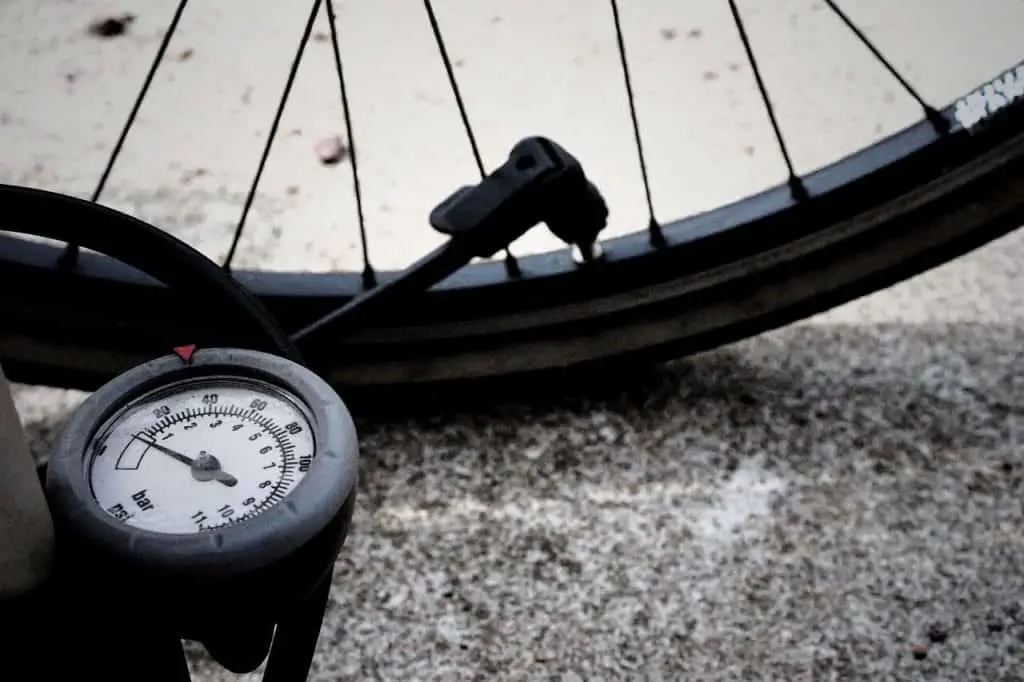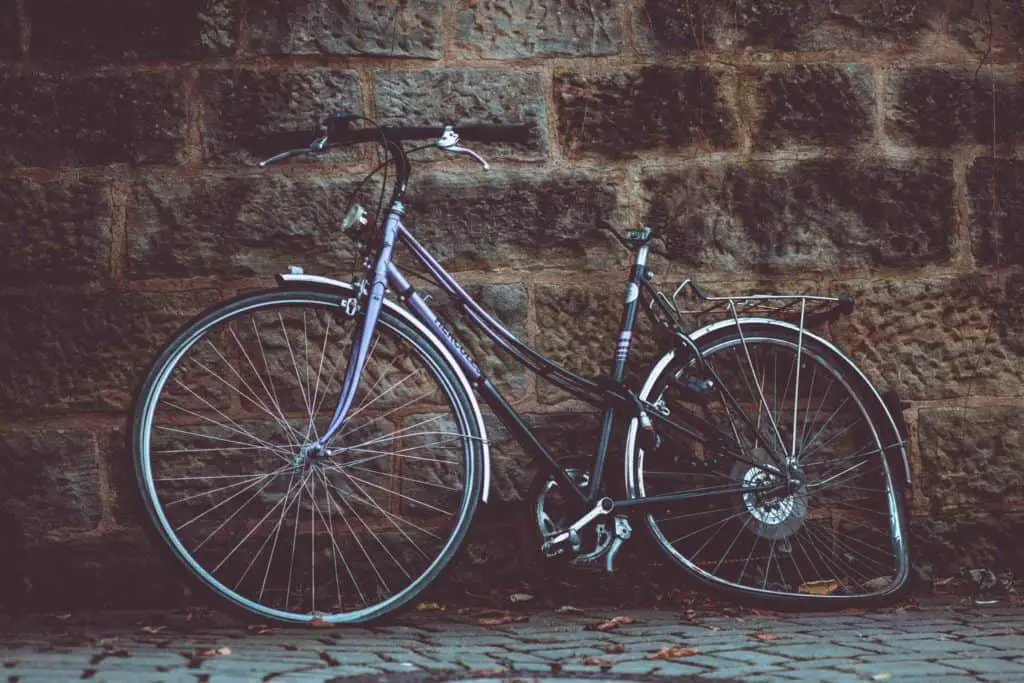
While nowhere near as serious as your frame breaking or a hangar snapping off, tire punctures are an annoyance you can do without. If you want to know how to prevent punctures on your road-bike tires, take a look at the handy tips I’ve compiled below.
How Do Punctures Happen?
There are three ways punctures can happen:
- Sharp foreign objects
- Sharp rim edges
- Hard impact
How to Prevent Punctures to Your Current Road-Bike Tires
Here’s what you need to do to puncture-proof your current road-bike tires.
Check Your Tires for Holes or Embedded Objects
Remove your tire and check it inside and out. Don’t worry if your tire looks worn on the outside. Inspect the fabric on the inside of your tire: If it’s smooth with no tears or anything poking through it, you’re good.
Don’t trust your eyesight 100% on this: Lightly press your fingers over the inside of your tire. If you feel anything sharp, try to get it out with your hands or a pick. Doing this every other day can help you catch a sharp object before it’s penetrated all the way through.
Check Your Tire Pressure Regularly
Make a habit of checking that your tires are pumped to the right pressure. This’ll vary depending on your weight and your tire width. Keep in mind that narrow tires need more pressure than wide tires, and road-bike tires specifically need 80 to 130 psi.
A good way to get the right pressure is to start in the middle between 80 and 130 psi, depending on your weight. The more you weigh, the higher your tire pressure should be. Make sure you’re always within your tire manufacturer’s recommended pressures.
Make sure to check your pressure regularly, even if the tire looks fine. The right pressure provides ideal resistance between the tire and the rim, which helps cut down on impact punctures.

Check Your Rim
Remove your tire and check both the rim tape and the rim on the inside. Your rim tape should look flat with no peaks or creases. It should also fully cover your spoke holes.
If your tires are a little old, the bed of the rim might be responsible for punctures. This happens when sharp edges stick out of the valve hole or the spoke hole. If your rim tape isn’t lying flat or covering your spoke holes, you need to replace it.
Rim tapes come in a vast array of weights and thicknesses, from light plastic types to heavy-duty fabric. Just make sure you get tape that’s the right size for your wheels.
Until your new rim tape arrives, old or low-quality rim tape will still give you better odds against punctures. Steer clear of electrical tape, which tends to distort under high pressure and can deform into your spoke holes.
Finally, check your valve hole for any sharp edges that can tear the tube with enough friction. If you find any, you can easily file them off until your valve hole is completely smooth.

Watch Your Step
You may not have the luxury of silky-smooth roads, but that doesn’t mean you have to let the cracks and potholes wreck your beautiful tires. Here’s what you can do if your daily commute is particularly rough.
Ride Prepared
Make a mental note of particularly problematic areas like potholes, crumbly asphalt, and gutters, where broken glass and heavy debris tend to accumulate.
Eyes on the Road
Try to look ahead for potholes, spiky debris, or anything sharp. Granted, this’ll cut into your enjoyment of the cycling experience. However, extra vigilance can not only protect your tires but also keep you and your bike safe from a fall.
Avoid Puddles
Puddles don’t just mean getting splashed with muddy water. They can hide a pothole or broken glass that could puncture your tires or throw you off your bike.
Loosen Your Grip
Holding your handlebars too tightly can make your front tire heavier, and therefore more easily punctured if you ride on something sharp.
Master the Bunny Hop
If you can manage the bunny hop, it can save you from crashing through debris that could puncture your tires. It’s especially useful if you’re dashing downhill or you can’t avoid a pothole.
Stop and Check Your Tires
Sometimes you simply can’t swerve around glass debris or a pothole and you have to ride through it. If that happens, stop as soon as you can and check the outside of the tires. If there’s something sharp lodged in, you can remove it before it makes its way through.
How to Prevent Punctures with New Equipment
Here are a few things you might want to invest in to further puncture-proof your tires.
Upgrade to a Better Tire
Usually, the tires that come with your road bike are the right choice for you. You might have to look at other options, however, depending on the kind of roads you ride on.
Get a Wider Tire
In general, 23mm tires are perfectly fine on smooth roads. But the less smooth your roads are, the thicker your tires need to be. You may need to invest in a 25mm tire or even a 28mm one, if it fits your road bike.
Thicker tires provide better resistance against impact punctures. Even though they weigh more, they tend to roll better at the same inflation pressure. This means your bike may be even faster than before.
Get a Heavy-Duty Tire
If the roads you regularly ride on are particularly rough, your best bet may be investing in a pair of puncture-resistant heavy-duty tires. They’re made of a reinforced high-density fabric that’s highly resistant to foreign objects and punctures in particular.
They’re not 100% puncture-proof, but they’ll reduce your punctures significantly and stay intact for much longer. Like wider tires, their only downside is that they’re a little heavier than narrow road-bike tires.
Go Tubeless
Tubeless tires are notorious for their drawbacks, but they provide an increased resistance to punctures. There are two benefits to tubeless tires:
- The liquid latex sealant inside them seals punctures without letting you feel any.
- Eliminating an inner tube means zero risk of impact punctures.
That said, some tears can be too big for the sealant to fix. This is pretty much the only puncture a tubeless tire won’t be able to protect your from.
Tubeless tires are probably the most expensive option on our list, because they can include an extra hidden cost: Most wheels and tires aren’t tubeless-compatible. This means an additional expense of buying brand-new tubeless-friendly wheels and tires.
If you’re a heavier rider, however, or your roads are particularly rough, they can be a wise investment.
Put Latex Sealant In Your Tubes
Latex sealant isn’t just for tubeless tires. You can use it on non-tubeless tires as well. Use a syringe when you fill your tire with sealant to avoid making a mess. Here are the simple steps:
- Draw 30-40ml of sealant into your syringe
- Remove the valve core on the inner tube of your tire
- Inject the sealant in your syringe into the inner tube
- Replace the valve core
You can use a non-latex sealant if you’re allergic to latex.
Line Your New Tires with Your Old Tires
Instead of getting rid of your worn-out tires, use them to boost your puncture resistance. Simply cut off the bead of the tire, then line your new tire with your old beadless one.
This’ll reduce your rolling resistance significantly. Consider it a way to puncture-proof your tires while also getting in a harder workout.
Flint Catcher
Possibly the old-school hack to end all old-school hacks, behold the flint catcher. It’s so old-school it’s not even a tire hack: It was actually first created for rim-brake frames, which makes it useless to disc-brake cyclists.
You can fashion a flint catcher out of, say, an old spoke, or you can add it to your retro shopping list. Then you bolt it onto the frame. The wire is now on the top of your tire, allowing it to slap any sharp objects away before they have a chance to penetrate your tire.
You Can’t Keep Your Tire Forever
When the time comes, you have to replace your tire with a new one. Hanging on to an expired tire may seem economical at first, but it puts you, your bike, and those around you at risk.
Know How to Fix a Flat
Keep in mind that regardless of the method you choose, you should always know how to fix a flat tire. This means keeping the necessary tools with you at all times.

The Bottom Line
Make a habit of checking your tires and wheels routinely. Make sure they’re inflated to the correct pressure. Consider wider tires if they fit your road bike, and keep an eye out while you’re on the road.
That said, learning how to change a flat tire is a vital skill so that if you do face a puncture, it won’t be the end of the world. It might delay you by a few minutes, but you’ll soon be back on your way. Happy trails!

